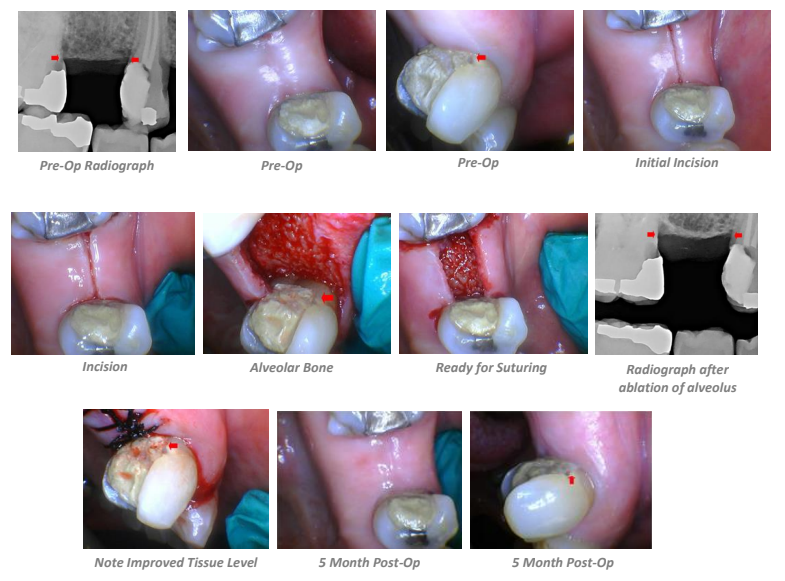Open Crown Lengthening #3 and #5
2 MIN READ
Open Crown Lengthening #3 and #5
By Joshua Weintraub, DDS on May 10, 2022
Case Summary:
This case involved #s 3 and 5, adjacent to edentulous #4 site. Seen radiographically with bone level indicated by red arrows, #3 mesial and #5 distal had inadequate tooth structure for restoration due to decay near the crest of the alveolus. The patient, a healthy 73-year-old female, was deciding between receiving an implant to replace #4, or a fixed partial denture from #s 3 to 5 with pontic #4. She was encouraged to seek an implant instead of a fixed partial denture (bridge) due to longevity, especially with her caries susceptibility. Tooth #5 had endodontic treatment and needs a core and full coverage restoration. Tooth #3 will be treated conservatively with a composite restoration if the patient does not choose a fixed partial denture. For the progression of this case in the photos, a red arrow is used in the distobuccal of tooth #5 to denote a reference point relative to tissue level, etc. See the pre- operative photo of #5 distobuccal compared to later photos for progression of tissue level apically.

Technique Used:
The patient was anesthetized with 1.7 ml articaine 4% with epinephrine 1:100,000 and 1.8 ml of bupivacaine 0.5% with epinephrine 1:200,000. The entire procedure was performed using the hard and soft tissue selection. The initial “scalpel like” Solea incision was made along the crest of the edentulous ridge using hard and soft tissue selection: 0.25 mm spot size, 1% mist and 50-70% cutting speed. The flap incision was continued using the same selection around teeth #s 3 and 5, severing the periodontal attachment, while not touching the adjacent tooth. Note the clean, linear precision of the incision with minimal to no bleeding. Next, the periodontal flap was raised using traditional periodontal instrumentation. For ablation of alveolar bone, Solea was used on the hard and soft tissue selection: 1.00 mm spot size, 100% mist and 60-70% cutting speed. Osseous tissue was ablated to establish the biologic width while exposing sufficient tooth structure coronal to the alveolus for proper restoration. The spot size was switched to 0.5 mm for more precise control ablating bone adjacent to the tooth structure. Note the good blood perfusion of the alveolar bone. After bone ablation prior to suturing, the red arrow shows the bone level relative to a reference point near the cementoenamel junction. The flap is shown prior to approximation and suturing. The level of the alveolar bone was checked radiographically prior to closure with the level of the alveolus indicated with red arrows. The flap was closed and sutured with four interrupted 3.0 silk sutures. The distobuccal of #5 can be seen with improved gingival tissue position immediately after suturing, as indicated by a red arrow at the reference point.
Results:
The patient was prescribed chlorhexidine 0.12% rinse, twice per day for 10 days and 500 mg of azithromycin on day one, and 250 mg on days two through five. The patient returned for suture removal nine days post operatively, healing well, with no evidence of infection. Due to caring for a sick husband, the patient did not return until five months later. The ridge and gingiva around teeth #s 3 and 5 were healthy (Figures 13a and 13b) with normal periodontal probing depths. With Solea, this procedure was completed without the patient having to go to a specialist. The procedure was less invasive and post-operative healing was faster, with greater patient comfort.
Solea Advantage:
With traditional tools, this procedure is typically completed with a scalpel and high-speed handpiece with burs. This would entail an injection of anesthetic, bleeding and sutures, likely taking more than an hour and a half to complete. Without Solea, this procedure would have been referred to a periodontist as the dentist would not be comfortable performing this procedure with high-speed handpiece due to significant risk of iatrogenic damage. With other lasers (i.e., erbium), the procedure would have taken longer to complete with much more bleeding and less precision. Due to Solea’s precision, a much smaller flap is needed than with traditional instruments. Therefore there is much less bleeding, resulting in a clean surgical site that allowed this procedure to be completed successfully. This also limited post-operative swelling and pain. Rapid healing was observed.
A Novel Approach to Treating Hairy Tongue
Case Summary: A 69-year-old woman presented to the clinic at Midwestern Universi...
2 min read
Infant Lingual and Maxillary Frenectomies
Case Summary: The patient, a 10-week-old male infant, presented with a Class III...
2 min read

